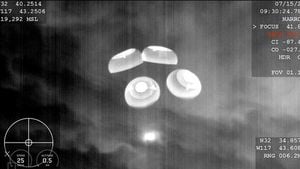A tragic accident at the Oxford Center in Troy, Michigan, has left the community devastated following the fatal explosion of a hyperbaric chamber. On Friday morning, emergency services received alarming reports around 8 a.m. about the explosion, which resulted in the death of five-year-old boy and injuries to his mother.
The young victim, reported to be from nearby Royal Oak, was present with his mother when the explosion occurred. This incident has raised serious concerns about the operation of hyperbaric chambers within the center, as experts indicate the facility was functioning without any state oversight or necessary accreditation.
John Peters, the Executive Director of the Undersea and Hyperbaric Medical Society, underscored the importance of having accredited facilities. He stated, “Every facility, regardless of how good they say they are, it’s just having someone look over your shoulder that's independent.” This calls attention to the lack of proper scrutiny of the Oxford Center, which has now been temporarily closed following the incident.
The chamber involved is used to provide hyperbaric oxygen therapy, which can be beneficial for treating serious medical conditions such as strokes, cancer, and autism. The chamber works by increasing air pressure inside, allowing the lungs to absorb more oxygen than normal, which can promote healing. Despite its benefits, it is also highly combustible—an inherent danger noted by Peters, who remarked, “Almost all of the hyperbaric accidents around the world have involved human error or human factors.”
According to reports, there were no federal or state regulations governing the operation of the Oxford Center’s hyperbaric facilities, prompting questions about the safety protocols the center had—or lacked—in place. Peters emphasized the potential risks for patients, warning, “If there is a lack of evidence, then patients are potentially being subjected to harm...”
It is important to highlight the discrepancy between the Oxford Center’s claims and the scientific backing for hyperbaric therapy. While the center boasts the ability to treat over 100 conditions, the Undersea and Hyperbaric Medical Society has accredited few, primarily centered around healing ulcers and skin wounds. This stark difference raises significant questions about the validity of the treatments advertised by the center.
The incident also sheds light on past controversies linked with the Oxford Center. Notably, it previously found itself under scrutiny when an employee was sentenced for abusing her position by stealing medical credentials and harming children with autism. These incidents raise more urgent calls for oversight, particularly after such tragedies as the recent explosion.
Following the explosion, the Oxford Center issued a statement expressing their condolences, emphasizing, “The safety and wellbeing of the children we serve is our highest priority. Nothing like this has happened in our more than 15 years of providing this type of therapy.” Nevertheless, the community and experts remain unconvinced, highlighting how this incident has shattered the trust placed in the facility.
The sorrow of losing such young life weighs heavily on the Troy community, who are now grappling with not only the loss but also the need for more stringent safety measures to prevent similar incidents from occurring again. Safety regulations around hyperbaric chambers are now at the forefront of discussions, emphasizing the urgent need for oversight to help safeguard patients across the state and beyond.



